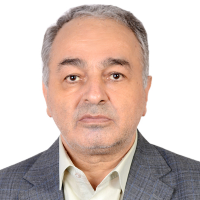Evaluation of the three empirical models in estimation of potential evapotranspiration(Case study: Urmia Lake basin)
Accurate estimation of crop water requirement is important especially in arid and semiarid climates. The rate of evapotranspiration can be measured by a lysimeter, however, it is expensive and its measurement is a cumbersome practice and time consuming. Therefore, many researchers use empirical models instead of direct measurements. Evapotranspiration of every crop is related directly to reference crop evapotranspiration (ET0). There are many empirical models for estimation of ET0. Among them the FAO-56 Penman-Monteith (FAO56PM) is known as the standard method in every climate. However, this method needs more climatic parameters which are not available everywhere. Therefore, identification of the model which needs less parameters and easily available climatic parameters will be useful. In this study three candidate models which had such conditions considered. These three models are i) Blaney-Criddle (BC), ii) Doorenbos and Pruitt (DP), and iii) Turk. The suitability of the candidate models compared with the output of the FAO56PM method. The main objective of this study is finding the most suitable model among the three candidate methods in Urmia Lake basin.
The region under study is the Urmia Lake basin located in North West of Iran. Nine stations selected across the basin. Meteorological data gathered from the Islamic Republic of Iran Meteorological Office (IRIMO). The method used here as a bench mark for evaluation of other empirical models is FAO-56 Penman-Monteith (FAO56PM). Three empirical models for ET0 estimation which need less climatic parameters are i) Blaney-Criddle, ii) Doorenbos and Pruit, and iii) Turk. These three models need climatidata that are easily available at least in the region. The recommended form of the FAO56PM method is as follows:ET_0=(0.484×Δ(R_(n-) G)+ϒ 900/(T+273) u_2 (e_s-e_a))/(Δ+ϒ(1+0.34u_2)) (mm day-1) [1] Where Rn is the net solar radiation (MJ/m2/day), G is the ground heat flux (MJ/m2/day), T is mean daily air temperature (℃), u2 is the wind speed at two- meter height (m/s), es is the saturated vapor pressure (kPa), ea actual vapor pressure (kPa). Other parameters explained in Allen et al. (1998).The first empirical candidate model for estimation of ET0 is the Turk model (Shuttleworth 1993) which reads:ET0 =0.31 T/(T+15)(S_n+2.09)(1+(50-RH)/70 ) ( 〖mm day〗^(-1) ) ,if RH<50% [2] Where Sn is the net solar radiation in (MJ/m2/day), RH is the relative humidity (%). If the average RH of a station is great or equal to 50%, then the second parenthesis will be removed from the equation, i.e. its value will be unity. The second empirical candidate model for estimation of ET0 is the Doorenbos and Pruitt (DP) model (Shuttleworth 1993) which reads:ET0 =-0.3+b_dp Δ/(Δ+γ) S_n 〖(mm day〗^(-1)) [3] where bdp calculated from the following relationship:b_dp= 1.066-0.0013 (〖RH〗_mean)+0.045 (U_d)-0.0002 (〖RH〗_mean)(U_d)-0.000315〖(〖RH〗_mean)〗^2-0.0011(〖U_d)〗^2 [4] The third empirical candidate model for estimation of ET0 is the Blaney-Criddle (BC) model (Fooladmand and Ahmadi 2009) which reads:ET0=(a_BC+b_BC f) ) 〖mm day〗^(-1)) [5] Where f=P(0.46T+8.13) [6] and a_BC= 0.0043〖RH〗_min - (n/N)- 1.41 [7] b_BC= 0.82-0.0041 (〖RH〗_min) + 1.07(n/N) + 0.066(U_d) -0.006(〖RH〗_min) (n/N) - 0.0006 (〖RH〗_min) (〖RH〗_min) (U_d [8] In [7] and [8] n is the actual sunshine hours and N is the maximum daily sunshine hours.In order to evaluate the models performances three criteria were used in this study which are i) coefficient of determination (R2), ii) root mean square error (RMSE), and mean absolute error (MAE). The output of models compared with that of the FAO56PM output in each of the selected stations.
Results showed that the median of R2 values of the Turk and BC were great than DP. The median of R2 values of both the Turk and BC were about 0.9. However, this measure for DP was about 0.75. The variance of R2 values in the case of BC was less than DP. The lowest value of RMSE belonged to the BC model which was about 2 mm/day. This value for other two models were more than 2 mm/day. The variance of RMSE obtained for all the nine stations was minimum comparing the three models. Therefore, according to Fig. 3, it can be suggested that when the RMSE was used for selection of the best model then the TURK model was superior than the others. However, when we considered all the three criteria for model selection, then the TURK model was superior than the others. According to Fig. 6 it can be concluded that in summer hot days the DP model overestimate the ET0 comparing the FAo56PM at Tabriz station. However, in the winter cold days DP underestimated the ET0 comparing the FAo56PM at the same station.
In this study three candidate models compared with the base model i.e. FAO56PM. Nine stations around the Urmia lake selected. Results indicated that the TURK model was suitable for ET0 estimation in Urmia Lake basin. This model only need three weather parameters which are i) Tmean, ii) actual sunshine hours (n), and relative humidity (RH). Logical use of fresh water in this basin is recommended.
- حق عضویت دریافتی صرف حمایت از نشریات عضو و نگهداری، تکمیل و توسعه مگیران میشود.
- پرداخت حق اشتراک و دانلود مقالات اجازه بازنشر آن در سایر رسانههای چاپی و دیجیتال را به کاربر نمیدهد.



